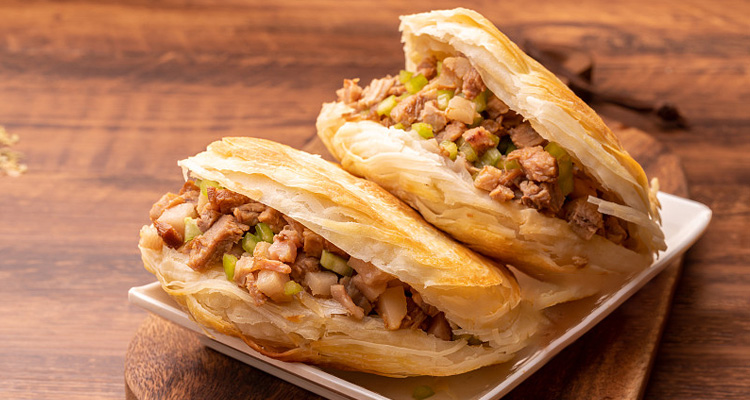Lingbao Roujiamo: A Traveler’s Guide to Henan’s Charcoal-Grilled Chinese Burger
1. Lingbao Roujiamo: a Central Plains “Chinese Burger” and a Crispy, Aromatic Feast
In the diverse world of northern Chinese wheat-based snacks, Lingbao roujiamo stands out as a local icon often called the “Chinese burger.” Its charcoal-crisped bun, soft interior, and slow-braised, flavorful pork create a satisfying balance of carbohydrates and protein. For many visitors to Henan, tasting Lingbao roujiamo is a must-do culinary experience.
2. A Taste Born from Adaptation and Local Tradition
Though not centuries old, Lingbao roujiamo has a lively origin story. In the 1980s, cooks in Lingbao adapted the roujiamo from neighboring Shaanxi, changing techniques and seasonings to suit local preferences. They switched to charcoal grilling for the bun and refined the braised pork recipe using a simmered “old broth” (laotang). These changes produced a distinctive regional specialty that soon became a proud culinary symbol across western Henan.

3. The Bun: “Iron Ring, Tiger Back, Chrysanthemum Heart”
The Lingbao bun is more than a carrier for meat — it’s an art form described locally as “iron ring, tiger back, chrysanthemum heart.” A perfectly baked bun has a raised, golden rim like an iron ring; the backside shows mottled, tiger-like browning; and the interior breaks into a soft, layered center resembling a blooming chrysanthemum. Skilled bakers use high-quality flour, precise kneading and shaping, and charcoal heat to develop that signature texture and smoky aroma that electric ovens cannot replicate.
4. The Soul: Old-Broth Braised Pork
If the bun is the structure, the braised pork is the soul of Lingbao roujiamo. Shops choose pork from the hind leg with a balanced fat-to-lean ratio. The meat stews slowly in a family-kept old broth with a blend of spices — Sichuan peppercorn, star anise, cinnamon, cloves and more — for several hours until tender but not falling apart. The long-simmered broth concentrates deep, layered flavors that make the pork aromatic and satisfying without excessive greasiness.

5. One Bite, Layers of Flavor and Texture
Authentic Lingbao roujiamo is assembled hot. Bakers split the fresh bun, fill it with finely chopped braised pork, and pour a spoonful of the boiling old broth into the pocket so the bun soaks up the savory juices. The first bite offers a crisp crust, a soft, fragrant center, and rich, saucy pork — a complex but harmonious mouthful that sets it apart from any fast-food sandwich.
6. How to Eat It Like a Local
For first-time tasters, a few tips enhance the experience. Always eat roujiamo while hot: fresh buns and warm pork deliver the best textures. Take a full bite to enjoy the contrast of crust, crumb and meat. Expect some dripping; hold it with both hands or use a napkin. Pair it with local accompaniments such as sour-spicy soup (suanla tang) or millet porridge to balance richness. The busiest, most authentic flavors are usually available at breakfast and lunchtime when ingredients are freshest.

7. Finding the Most Authentic Stalls in Lingbao
Lingbao’s streets are dotted with roujiamo vendors, but flavors vary. Look for humble, long-running stalls with a charcoal grill visible and a steady line of locals — a reliable sign of authenticity. Many shops offer variations with green peppers, cilantro, or an added fried egg. A typical, hearty roujiamo in Lingbao costs around RMB 10, excellent value for a filling traditional meal. Lingbao is conveniently reachable by high-speed rail from Zhengzhou or Xi’an, making it an easy stop on a Henan–Shaanxi food route.
8. A Simple Home Version to Try
If you can’t visit Lingbao right away, try a simplified home recipe. Pan-sear flatbreads over medium-low heat to mimic the toasted rim; aim for golden spots and a slightly crisp edge. Braise pork shoulder or belly with store-bought braising spice mix, soy sauce, cooking wine, rock sugar, scallion and ginger for 1–2 hours until tender. Shred the meat, mix with reduced braising liquid, stuff into the split flatbread, and drizzle with hot broth. While it won’t fully match the charcoal aroma or the aged old broth, this gives a pleasant approximation of Lingbao’s flavors.

9. Conclusion: A Central Plains Culinary Gem Not to Miss
Lingbao roujiamo may be humble in presentation, but its craftsmanship and flavor are deeply rooted in local tradition. Each charcoal-baked bun and spoonful of old-broth pork reflects generations of refinement. For travelers exploring China’s food map, Lingbao offers an authentic, unforgettable bite of Henan: crispy, tender, aromatic — a true Central Plains delicacy waiting to be tasted.


